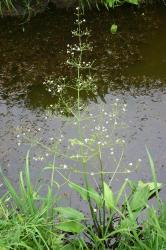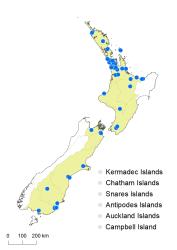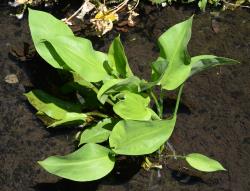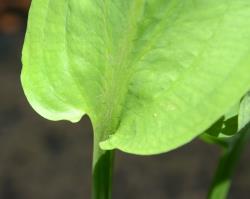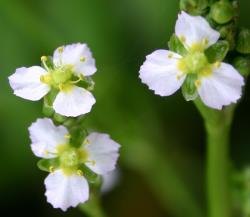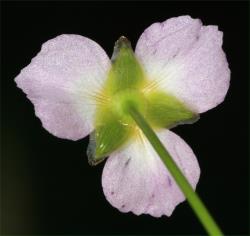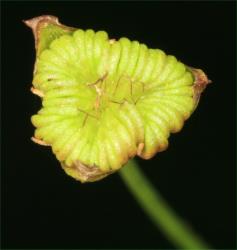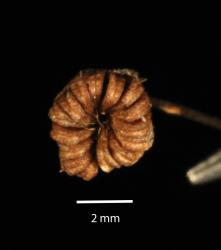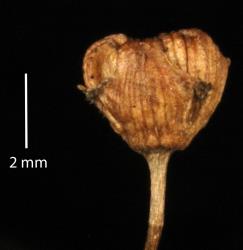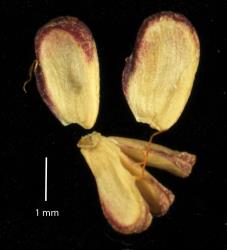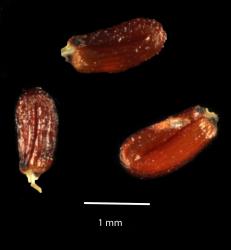- Taxon
- Gallery
Perennial, rhizome short; leaves erect (rarely floating or submerged) from a stout basal rosette 0.5–1.8 m tall. Leaves long petiolate; lamina 80–230 mm long, 30–100 mm wide, broad elliptic (emergent or terrestrial leaves), elliptic, ovate, base obtuse to cordate, apex acute or acuminate, margin entire. Petioles 50–420 mm long, 3.0–9.0 mm wide, D-shaped, septate. Inflorescence a whorled panicle of (3–)4–9 verticels, pyramidal, bracteate, 300–1080 mm tall, 230–600 mm wide. Flowers 4.0–10 mm diameter, pedicels terete, 14–35 mm long, glabrous. Sepals green, 3.0–4.0 mm long, ovate. Petals pale lilac or pale pink with a yellow spot at the base, 4.0–4.5 mm long, 4.0–6.4 mm long, 4.8–6.5 mm wide, broadly elliptic to rhombic, apices rounded, occasionally acute, margin denticulate. Stamens 6, filaments membranous, 1.4–2.5 mm long, flattened, tapering, anthers yellow, 0.8–1.2 mm long, ellipsoid. Carpels 18 to 23 in a ring; style 0.7–1.5 mm long, more or less straight, lateral on the ventral side attached below middle; stigma less than ½ the style region, papillose, papillae 20–45 µm long. Fruiting head more or less triangular, ventral sides of achenes not meeting in the centre. Achenes 1.8–2.8 mm long, 1.2–1.6 mm wide, obovate (horseshoe-shaped), dorsal sutures 1–(2), straw coloured or light brown. Seeds 1.4–1.5 mm long, 0.5–0.6 mm wide, uncinate, smooth to faintly rugose, red-brown. Dispersal units: achenes floating in water (hydrochory).
This species can be distinguished from Alisma lanceolatum by its broader elliptic or ovate leaves with obtuse to cordate leaf-bases (in emergent leaves), rather than the lanceolate or narrow-elliptic leaves and cuneate leaf-bases of the above. It can, however, be difficult to distinguish young, non-flowering plants from A. lanceolatum. Although the flowers are very similar in the two species, petal colour is reported as pale lilac in A. plantago-aquatica and usually pale pink in A. lanceolatum (Healy & Edgar 1980). Of more diagnostic value are the petal apices, which in A. plantago-aquatica are usually more rounded and denticulate, whereas in A. lanceolatum they are often acute or acuminate and the margin entire or irregularly toothed. The fruiting head of A. plantago-aquatica has a distinctive gap in the centre (as seen from above), caused by the ventral edges of the achenes not meeting, whereas in A. lanceolatum there is no gap as the ventral sides of the achenes touch and overlap, forming a tight cluster. The fruiting head-shape side-on is also different in the two species, with A. plantago-aquatica cup-shaped and A. lanceolatum somewhat compressed.
North Island: Northland – Kaitaia, Awanui River, Waipapakauri, Mamaranui, Kaiwaka, Whangaroa, Aponga; Auckland – Waitakere, Kakamatua Estuary, Āwhitu, Great Barrier Island (Kaitoke Creek), Waikato River (near Elbow), Aka Aka, Wairoa River, Drury, Pukekohe, Mercer, Meremere, Waikato River near Orton, Pukekawa, Hauraki Plains, Whangamarino wetland, Lake Waikare, Lake Rotokawau, Hamilton City; Volcanic Plateau – Ōhau Channel near Lake Rotoiti, Matatā, Ōpōtiki; Taranaki – near Waitara; southern North Island – Featherston, Fernside.
South Island: Sounds-Nelson – Nelson City; Marlborough – Blenheim (Opawa River), Canterbury – Lincoln, Timaru, Levels, Washdyke, Winchester; Otago – Taieri Plains, Balclutha, Toko River, Lake Tuakitoto, Kaitangata; Southland – Invercargill.
iNaturalistNZ records: https://inaturalist.nz/observations/1121657, https://inaturalist.nz/observations/4788352, https://inaturalist.nz/observations/40555601, https://inaturalist.nz/observations/37624948, https://inaturalist.nz/observations/37624895, https://inaturalist.nz/observations/36707943.
Emergent or marginal in humus-rich soils in farm drains, roadside ditches, swamps, swamp drains, pools and ponds, edges of slow-flowing streams and rivers, estuaries, marshy pasture. Recorded from oligotrophic and eutrophic water bodies, and some tolerance of brackish water evident.
Notes: Björkqvist (1967) reports that this species has the broadest ecological range of European Alisma species. It reproduces by seed, or vegetatively from side shoots of the rhizome. Seeds exhibit dormancy. In New Zealand, plants can survive the winter with submersed leaves in protected parts of water bodies such as shaded drains. Emergent leaves wither and die back over winter. Reported by Björkqvist (1967) to be a poor competitor and favoured by cultivation.
CHR 1287, E.B. Levy, Waikato, March 1929 (cited in Healy & Edgar (1980), p. 34).
Flowering: Nov.–Feb. Fruiting: Dec.–Mar.
2n = 14 (Erlandsson 1946, Björkqvist 1968).



